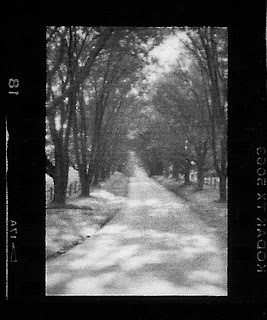The long wait
Before digital cameras, you could shoot one roll of film and you’d be thrilled if two or three* photos out of 36 were gems.
(*Good catch, anonymous editor!)
And it took time to get at those gems. You didn't always shoot a full roll of film in a go—it might spend weeks wound around the spools in your camera. Then maybe you’d wait till you had two or three rolls saved up before you took them into the darkroom or down to the local drugstore.
You had to wait a week for the prints to come back or spend
time in the darkroom mixing chemicals, pouring them in the proper order, timing
everything just right, listening to the tick of the timer, agitating and
rinsing, all the while never knowing if you’d get a worthless strip of opaque
celluloid in exchange for your efforts.
Then you’d unwind the spool and hang
the negatives up to dry. After some more waiting you’d snip them up, put them
under glass, make a contact sheet and—finally!—turn on the lights to see the
results.
The bad pictures
Inevitably, there’d be one or two great ones and a handful of good ones. But there would be many more bad ones—misfires beyond repair. Out of focus, hopelessly overexposed, boring subjects, horrible compositions.
Inevitably, there’d be one or two great ones and a handful of good ones. But there would be many more bad ones—misfires beyond repair. Out of focus, hopelessly overexposed, boring subjects, horrible compositions.
And those bad photos were right there in front of you, right
next to the good ones, serving as permanent context—black and white proof that you are not perfect. You took it in stride, because
the good photos, even if they weren't all perfect, were so much better than the
bad ones. Instead of despairing over the bad photos, you learned from them. It was a normal and expected part of the process.
Take a look at the contact sheet at the top of this post--some of the photos are snapshots, some are tilted, most have blown skies, some way over- or way under-exposed. But there are three, maybe even four, that I liked. (Wish I still had the prints--these thumbnails are cropped from the scan of the contact sheet, which is why they look like fuzzy bits of shite).
Three or four good photos out of 30. Success!
See? Context.
 The reality check
The reality checkDigital is good for the ego; not so much for objectivity. With digital, you can review a photo as soon as you take it and delete it in an instant if it’s crap. You can fiddle with the settings and re-shoot the same scene over and over until you get it just right. It’s as if those crappy photos never existed—as if every picture you take is effing brilliant.
So what happens when you bring your memory card back home, plug it into the computer, look at a page of thumbnails, open some up in full screen and realize that what looked great on the small LCD screen on your camera isn't as good as you thought? Do you chalk it up to the learning process? Do you feel proud of the ones that did come out well? Or do you focus in on and beat yourself up about the ones that suck?
For me, unfortunately, it’s the latter.
And that's exactly what happened when I got back from Paris.
And this is a very long way of getting to my point about ...
The shitty Paris pics
The shitty Paris pics
I don’t remember doing it, but I
know why I did it.
I did it because digital photography has tricked me into thinking that all of my photos should be effing brilliant. And when
they’re not effing brilliant, the blow is more painful in digital format than
it would be on film.
When I got back from Paris, I
plugged in my memory cards, opened up the page of thumbnails, and focused on
the ones I hated. And I hated a LOT of them.
There was no way I could have lived up to my expectations
for that trip and the brilliant photos I planned to take there. But I also didn't expect to come back with as many truly crappy pictures as I did. (A fall down the hotel stairs and a badly sprained ankle that cut
my trip short by a couple of days didn't help matters.)
Time and emotional distance
So… two years later, can I look at my Paris pictures with
some emotional distance? Can I look at them as a group without focusing in on
all the bad ones?
It’s complicated. That trip was awesome. But I think I’ll always feel bad about the
photos I took on it.
Anyway, recently I went through some of the pics again, tried to look at them as they are rather than how I hoped they would be. And yes, it turns out there are a few that I like. I’d put the number at about 2 out of every 36.
Anyway, recently I went through some of the pics again, tried to look at them as they are rather than how I hoped they would be. And yes, it turns out there are a few that I like. I’d put the number at about 2 out of every 36.


2 comments:
Mizz Perfectionist,
"you’d be thrilled if two or photos out of 36 were gems."
Anyways, it was a good read. I don't have any experience in film photography but I can imagine - not reminisce - its disadvantages and advantages over digital.
To your final questions: Yes. No. Yes, with some.
Thanks for the edit! :)
Post a Comment